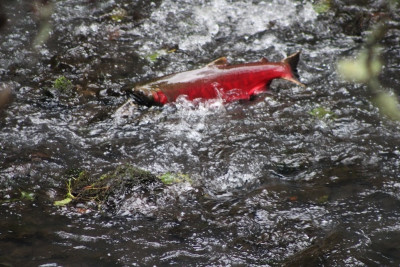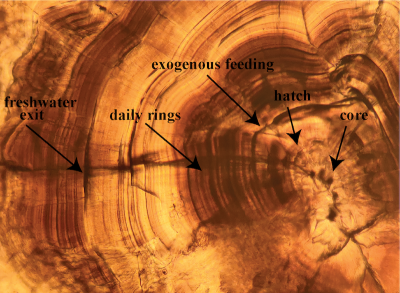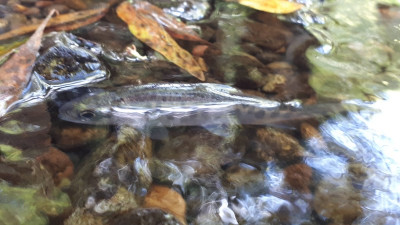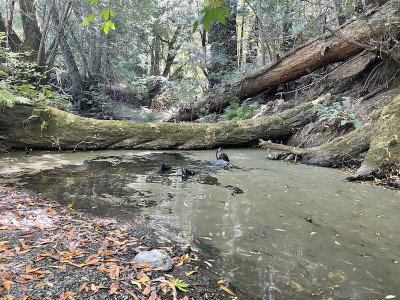When Rachael Ryan went to the Lagunitas Creek watershed in Marin County in the summer of 2021, she felt dejected. The river basin, roughly an hour north of San Francisco, shelters one of the largest and most stable remaining wild populations of endangered coho salmon (Oncorhynchus kisutch) along the Central California coast. But after another year with too little rain “there were all these fish trapped in tributaries and pools that were drying up,” Ryan recalls. “It was sad to watch in real time how drought impacted these fish.”
It made for an inauspicious start to Ryan’s California Sea Grant-funded graduate research project: to study how the changing precipitation patterns in California affect the spawning and migration of coho salmon. Only a few thousand adults are thought to remain in the wild, down from possibly over 100,000 in earlier decades. Each year, juvenile coho migrate downstream to the ocean. Later, they return to their natal stream to spawn the next generation. But as California’s winter rainy season is becoming sharper and shorter, more shallow tributaries dry out during the year, obstructing this outmigration as well as the return trip. Inevitably, this further threatens the shrinking coho population.
Or so it was thought.
Ryan found that at least some coho seem to find ways to deal with vanishing streams, even in dry years. “It’s pretty cool,” says Ryan, who made the discovery by studying a body part that few people suspect in a fish: their ears.
Little black boxes
Bony fish such as salmon have ears that sit just behind their gills. Each contains small bone-like structures made from calcium carbonate called otoliths, sometimes described colloquially as “ear stones.” The stones help the fish stay oriented while moving. As it swims and turns, the otoliths move around the ear chamber like marbles in a cup. The signals this sends to the fish’s brain aid it in keeping its balance. (Humans, too, have otoliths, for the same reason.)

But otoliths are also like tiny equivalents of the black box on a plane in that they record where a fish travels. That’s because these ear stones grow every day by laying down a new layer of calcium carbonate. As they do, they incorporate chemicals such as magnesium, strontium and copper from the waters through which the fish is swimming and which differ subtly depending on the location. Saltwater has a different chemical signature than freshwater and even the chemical makeup of neighboring streams can diverge based on the local geology.
By studying otoliths’ ring patterns, scientists can retrace where a coho has journeyed over its lifetime: where it was born, when it migrated to the ocean and returned, and which waters it passed through along the way. "Otoliths essentially record the entire life history," Ryan says.
Finding chemical fingerprints
The otoliths Ryan used in her study came from coho salmon that had returned from the ocean to spawn then died in the Lagunitas Creek watershed over a period of almost ten years. But before Ryan could decode their information, she had to learn how to polish these small structures to reveal the individual layers and their chemical compositions. "It was months of trial and error,” she recalls. “I broke so many otoliths at first. Luckily, there are otoliths in each of the two ears, so there's some room for error.”
The process involved mounting each otolith, about as big as a grain of rice, then filing it down, first with a specialized grinder, then by hand, from increments of 100 microns to as small as ten microns, which is about one-tenth as wide as a strand of hair.

"You're checking constantly under the microscope as you grind, to make sure you’re not obliterating the core and those incredibly fine daily growth rings," says Ryan. Now, 151 otoliths later, the motions have become muscle memory. Once polished Ryan sent otoliths to a special plasma mass spectrometer at the University of California, Davis, to determine their mineral composition.
Ryan also made many trips back to the watershed to sample the creeks for chemical analysis to get the creek “fingerprint.” Lagunitas Creek straddles two tectonic plates — the North American and Pacific plates — making its geology exceptionally diverse. "Even small tributaries can have totally different chemical signatures than the main creek," Ryan says. "The more we sampled, the more unique fingerprints we uncovered."
Mystery fish
Once she started comparing the data from the water with the chemicals found in the otoliths, Ryan found surprises. Experts assume that most coho in California spend one year in the freshwater streams in which they hatched before migrating to the ocean. They live in the sea for one to two years before returning to their natal streams to spawn. “We have this idea of what the fish are doing,” says Ryan. However, the otoliths revealed that there is much more variation to this general life strategy than experts had thought.
Some of the coho in Ryan’s sample appear to have left their natal streams sooner than expected to migrate to the ocean before successfully returning to spawn years later. Even more surprising was that others strayed far from where they were born — possibly venturing to different watersheds altogether. At least that’s the conclusion that Ryan draws from finding coho in Lagunitas Creek whose otolith chemical fingerprint doesn’t match any of the water she has found there. “They are our mystery fish,” the grad student says. “Since I can't sample all the water on the California coast, we don’t know where they came from.”

Over the next months, Ryan plans to model these life histories in greater detail. But finding that some coho venture into new watersheds, rather than returning to their birth streams, suggests to her that coho salmon work much more flexibly with the waters they find than had seemed conceivable. And that, she thinks, is encouraging news: “Even in really dry years, there are still possibilities.”
Intermittent streams
Take the intermittent streams, those small tributaries that routinely dry out as spring progresses into summer. “Coho can grow rapidly in these tributaries early in the season, but the fish need to get out in time,” says Ryan. The otoliths she studied indicate that at least some do, even in years of drought conditions. At the same time, returning adult coho seem to find their way to streams that might not have been around when they hatched, Ryan has noticed. “There are years when there's no spawning in the tributaries and yet we see spawning fish in them three years later when the coho return.”
For Ryan, this highlights that we shouldn’t discount any part of a habitat: “Intermittent streams often get a bad reputation. People see them dry up and think nothing can live in there. But our data shows that these streams are actually contributing to the coho population.”
It has made her more optimistic about the fate of the species. Some months ago, she went back to the tributaries she had visited at the beginning of her project. Back then, she found almost no juveniles in the tributaries that were drying out.

Since now is the time when the coho from that year are scheduled to return to their natal streams, it would have seemed logical if there had been few to none. Yet Ryan did find coho. More than she would have predicted. And not just the regular three-year-olds. Ryan also spotted many two-year-old cohos, called “jacks,” that had returned a year before schedule. Usually this happens when there is a cohort in the ocean that is unusually strong, making some fish seek a head start by heading back a year early, Ryan says.
The coho of Lagunitas Creek seem to have rebounded. Ryan thinks much of it has to do with being less strict in their choices that we assume. “We’re finding a lot more variation than we anticipated,” she says. “The coho are more resilient than we thought.”
About California Sea Grant
NOAA’s California Sea Grant College Program funds marine research, education and outreach throughout California. Headquartered at Scripps Institution of Oceanography at the University of California San Diego, California Sea Grant is one of 34 Sea Grant programs in the National Oceanic and Atmospheric Administration (NOAA), U.S. Department of Commerce.